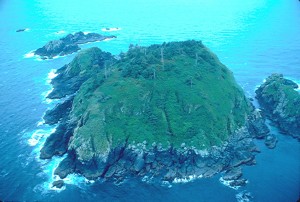
News/Reports
Beresford Island ER #12 Overview: Physical and Biological
Original Purpose: To protect colonies of nesting seabirds and their habitat
 Physical: A small, rocky island, roughly oval in shape, which rises steeply from deep water to a rounded top. The shore is rock and the upper slopes tend to have less soil cover than Triangle and Sartine islands. A number of rocks and reefs occur in close proximity to the main island.
Physical: A small, rocky island, roughly oval in shape, which rises steeply from deep water to a rounded top. The shore is rock and the upper slopes tend to have less soil cover than Triangle and Sartine islands. A number of rocks and reefs occur in close proximity to the main island.
Of the three outermost islands in the Scott group, this is the only one which supports trees. These are Sitka spruce, very old and much battered by the elements, growing on the rounded summit of the island. Red elderberry and black twinberry, confined largely to the summit, are the dominant shrubs, and tufted hairgrass is the most widespread herb. Interesting rare plants of the rocky slopes are hairy goldfields growing in crevices just above the surf, and North Pacific draba somewhat higher up. Twenty-five species of vascular plants have been recorded.
See the complete BC PArks File in PDF : beresford
Biological: A 1987 survey by the Canadian Wildlife Service recorded approximately 168,000 nesting seabirds on Beresford Island. The only land mammal present is a large-bodied endemic race of Deermouse. Stellar Sea Lions use Beresford and adjacent rocks as a breeding rookery. In recent years 600-800 Sea Lions have been present in summer; about 100 in winter. Up to 6000 Sea Lions bred at Beresford in the early part of this century but numbers were reduced by shooting of over 12 000 animals between 1913 and 1966. It is likely Sea Otter were common in the surrounding marine environment prior to extripation. Occasional sightings are becoming more frequent indicating that Sea Otter are re-establishing colonies in this area.
Significant Species:
(Red Listed) Northern Abalone
(Blue Listed) Abalone, Northern (Haliotis kamtschatkana)
Auklet, Cassin’s (Ptychamphus aleutius)
Cormorant, Pelagic (Phalacrocorax pelagicus)
Cormorant, Brandt’s (Phalacrocorax penicillatus)
Deermouse (Peromyscus maniculatus)
Eagle, Bald (Haliaeetus leucocephalus)
Falcon, Peale’s Peregrine (Falco peregrinus pealei)
Guillemot, Pigeon (Cepphus columba)
Gull,Glaucous-winged (Larus glaucescens)
Murre, Common (Uvia aalge)
Otter, Sea (Enhydra lutris)
Oystercatcher, Black (Haematopus bachmani)
Puffin, Tufted (Fratercula cirrhata)
Seal Harbour (Phoca vitulina)
Sea Lion, Steller (Eumetopias jubatus)
Sparrow, Fox (Passerella iliaca)
Sparrow, Song (Melospiza melodia)
Storm-petrel, Fork-tailed (Oceanodroma furcata)
Storm-petrel, Leach’s (Oceanodroma leucorhoa)
Threats:
Climate Change:
The IPCC has projected an increase in sea surface temperature and raised sea levels, both of which could result in changes in the presence and life cycles of marine species which are important food sources for the protected seabird populations. The loss of synchrony between seabird phenology and seasonal food source availability has already been documented on Triangle Island. Such shifts would have a resounding effect in all other biotic members of the community.
Harvest:
Commercial and recreational fishing disturbs marine ecosystems and shorebird activity. Vessel traffic in the vicinity can be the cause of mortality in seabirds and marine mammals especially as the source of chronic oiling.
Recreation:
Close approach by marine or air traffic disrupts marine mammals and seabirds.
Flora:
draba, North Pacific (Draba hyperborea)
elderberry, red (Sambucus racemosa var. arborescens)
goldfields, hairy (Lasthenia maritima)
hairgrass, tufted (Deschampsia cespitosa)
spruce, Sitka (Picea sitchensis)
twinberry, black (Lonicera involucrate)
Fauna:
Abalone, Northern (Haliotis kamtschatkana)
Auklet, Cassin’s (Ptychamphus aleutius)
Cormorant, Pelagic (Phalacrocorax pelagicus)
Cormorant, Brandt’s (Phalacrocorax penicillatus)
Deermouse (Peromyscus maniculatus)
Eagle, Bald (Haliaeetus leucocephalus)
Falcon, Peale’s Peregrine (Falco peregrinus pealei)
Guillemot, Pigeon (Cepphus columba)
Gull,Glaucous-winged (Larus glaucescens)
Murre, Common (Uvia aalge)
Otter, Sea (Enhydra lutris)
Oystercatcher, Black (Haematopus bachmani)
Puffin, Tufted (Fratercula cirrhata)
Seal Harbour (Phoca vitulina)
Sea Lion, Steller (Eumetopias jubatus)
Sparrow, Fox (Passerella iliaca)
Sparrow, Song (Melospiza melodia)
Storm-petrel, Fork-tailed (Oceanodroma furcata)
Storm-petrel, Leach’s (Oceanodroma leucorhoa)
